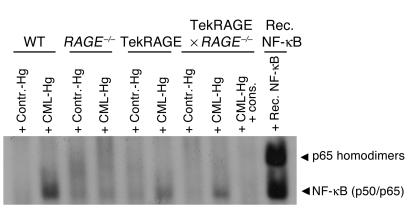Figure 3.
NF-κB inducibility in peripheral blood mononuclear cells of the various mouse strains. Six-month-old WT, RAGE–/–, Tie2RAGE, or Tie2RAGE ∞ RAGE–/– mice received unmodified control hemoglobin (Contr.-Hg) or CML-modified hemoglobin (CML-Hg) (1,000 ∝g/mouse at time point 0, intraperitoneally). Six days later, mice were sacrificed and NF-κB–binding activity was determined in total blood. Recombinant NF-κB (Rec. NF-κB) produced in erythrocyte lysates served as control for NF-κB binding. To confirm NF-κB binding, binding activity at 6 days was competed with a 160-fold molar excess of unlabeled consensus NF-κB oligonucleaotides (cons.). Arrowheads indicate NF-κB complexes consisting of NF-κB homodimers or NF-κB (p50/p65) heterodimers, respectively.

